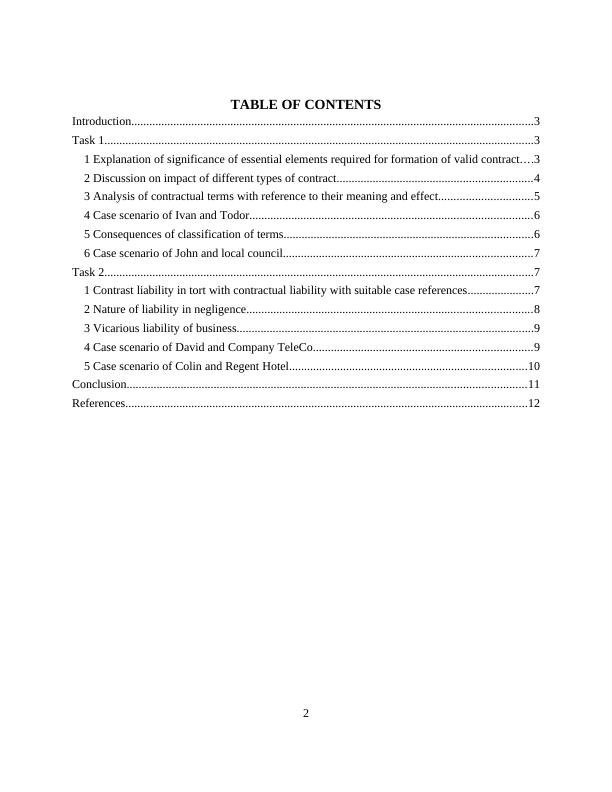Study on Contract and Tort Law
Added on 2020-02-03
12 Pages4031 Words146 Views
ACNB

TABLE OF CONTENTSIntroduction......................................................................................................................................3Task 1...............................................................................................................................................31 Explanation of significance of essential elements required for formation of valid contract....32 Discussion on impact of different types of contract.................................................................43 Analysis of contractual terms with reference to their meaning and effect...............................54 Case scenario of Ivan and Todor..............................................................................................65 Consequences of classification of terms...................................................................................66 Case scenario of John and local council...................................................................................7Task 2...............................................................................................................................................71 Contrast liability in tort with contractual liability with suitable case references......................72 Nature of liability in negligence...............................................................................................83 Vicarious liability of business...................................................................................................94 Case scenario of David and Company TeleCo.........................................................................95 Case scenario of Colin and Regent Hotel...............................................................................10Conclusion.....................................................................................................................................11References......................................................................................................................................122

INTRODUCTIONLegislation of contract and negligence is covered under the provisions of civil law.Objective of both the legislation is to ensure fair conduct by parties in order to reduce thepossibility of injury. In order to attain this objective, standard norms are prescribed by thelegislation which are mandatory to be complied by all the parties (Adams, 2010). Present study isfocused on description of legal norms described under the contract and tort law. Described legalprovisions will be linked to the given case scenario in order to provide justifiedrecommendations to the parties. Further, case scenario will be linked to previous case precedentsfor better understanding. TASK 11 Explanation of significance of essential elements required for formation of valid contractAll contracts are agreement but all agreements cannot be considered as valid contractbecause of the absence of its essential elements. By considering this aspect, parties are requiredto incorporate all the essential elements in the agreement for the formation of valid contract(DiMatteo, 2012). Description of the importance of essential elements required for the formationof valid contract is enumerated as below:Offer: Offer is an initial point from where a proposal gets formal introduction for theformation of legally binding contract. It can be termed as an expression by one party toanother for refrain doing or not doing a particular task (McKendrick, 2012). Offer mustbe communicated and it can be revoked any time prior to its acceptance. It must bespecific and lawful. According to the case of Harvey v Facey [1893] UKPC 1, agreementbetween parties was not enforceable because offeror had provided uncertain offer byusing term, the lowest price. Acceptance: An offer is said to be agreement if it is accepted by the person to whom itwas made. Acceptance signifies the assent provided by offerree; thus it is essence ofcontract (Milner, 2011). Acceptance must be unconditional and not be supported bymodification else it will be considered as a counter offer. In case of Hyde v Wrench(1840) 49 ER 132, contract was not valid by court of law because offerree had madeconditional acceptance.3

Intention: Parties to the contract must have intention for the formation of lawfulagreement for the accomplishment of promise made by them. In situation of the absenceof intention, agreement will not be enforceable. By considering this element, domesticand charitable agreements do not have legal enforceability (Zoll, 2012). This factor wasalso considered in case decision of Jones v Padavatton [1969] 1 WLR 328.Consideration: In legal terms, consideration refers to the something to be done at thepromise made by promiser. According to English law, consideration is required to besufficient but it is mandatory to be adequate (Contract consideration, 2015). This aspectwas applied in case of Chappell v Nestle [1960] AC 87. In this case, court concluded thatthey are interested in bargaining capacity of parties. Thus, validity will only beconsidered by its fairness.Privity: Privity is a legal doctrine according to which third party is not in position tomake claim of damages on the behalf of contractual parties (Mann, 2002). For this aspect,case of Dunlop Tyre Co V Selfridge can be considered. In this case, claim of damages byclaimant was not considered because he was not direct party to the contract. 2 Discussion on impact of different types of contractUnilateral contract This contract is created by offer and accepted by the performance. This contract isformed as express offer by one party which can be accepted through performance by anyindividual.Impact: In such contracts, no individual is entitled for performance. However, ifperformance is provided by individual, then offeror will be obliged for the completion oftheir promise (Plimpton, 2007).Case: In the case Carlil v Carbolic Smoke Ball, defendant was held liable to accomplishpromise on the performance provided by claimant. Bilateral contract Bilateral contracts are formed by mutual exchange of promises by the parties. All thecontracting parties are required to provide performance to discharge contract by performance.Impact: Faulty party will be held liable for breach if they fail to satisfy contractual terms(Rush and Ottley, 2006). 4

End of preview
Want to access all the pages? Upload your documents or become a member.
Related Documents
Essential Elements of a Valid Contract - ACNB Assignmentlg...
|13
|3846
|60
Contractual terms and conditions: Task 13lg...
|13
|3839
|131
Aspects of Contract and Negligence for Business- Reportlg...
|12
|4138
|68
Essential Elements of Contract (PDF)lg...
|12
|4347
|189
Aspects of Contract and Negligence for Business : essential elements of a valid contractlg...
|15
|5258
|162
Report On Elements Of Contracts & Impact In Different Business Scenarioslg...
|12
|4117
|123
